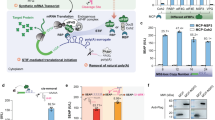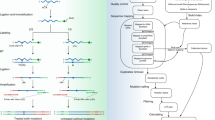Abstract
Tissues and organs are composed of diverse cell types, which poses a major challenge for cell-type-specific profiling of gene expression. Current metabolic labeling methods rely on exogenous pyrimidine analogs that are only incorporated into RNA in cells expressing an exogenous enzyme. This approach assumes that off-target cells cannot incorporate these analogs. We disprove this assumption and identify and characterize the enzymatic pathways responsible for high background incorporation. We demonstrate that mammalian cells can incorporate uracil analogs and characterize the enzymatic pathways responsible for high background incorporation. To overcome these limitations, we developed a new small molecule–enzyme pair consisting of uridine/cytidine kinase 2 and 2′-azidouridine. We demonstrate that 2′-azidouridine is only incorporated in cells expressing uridine/cytidine kinase 2 and characterize selectivity mechanisms using molecular dynamics and X-ray crystallography. Furthermore, this pair can be used to purify and track RNA from specific cellular populations, making it ideal for high-resolution cell-specific RNA labeling. Overall, these results reveal new aspects of mammalian salvage pathways and serve as a new benchmark for designing, characterizing and evaluating methodologies for cell-specific labeling of biomolecules.
This is a preview of subscription content, access via your institution
Access options
Access Nature and 54 other Nature Portfolio journals
Get Nature+, our best-value online-access subscription
$29.99 / 30 days
cancel any time
Subscribe to this journal
Receive 12 print issues and online access
$259.00 per year
only $21.58 per issue
Buy this article
- Purchase on Springer Link
- Instant access to full article PDF
Prices may be subject to local taxes which are calculated during checkout





Similar content being viewed by others
Data availability
All structures have been deposited in the Protein Data Bank (6N53, 6N54 and 6N55). RNA sequencing datasets have been deposited in the Gene Expression Omnibus (GSE136638).
References
Jung, J. & Jung, H. Methods to analyze cell type-specific gene expression profiles from heterogeneous cell populations. Anim. Cell Syst. 20, 113–117 (2016).
Feng, H., Zhang, X. & Zhang, C. mRIN for direct assessment of genome-wide and gene-specific mRNA integrity from large-scale RNA-sequencing data. Nat. Commun. 6, 7816 (2015).
Handley, A., Schauer, T., Ladurner, A. G. & Margulies, C. E. Designing cell-type-specific genome-wide experiments. Mol. Cell 58, 621–631 (2015).
Riley, K. J., Yario, T. A. & Steitz, J. A. Association of argonaute proteins and microRNAs can occur after cell lysis. RNA 18, 1581–1585 (2012).
Mili, S. & Steitz, J. A. Evidence for reassociation of RNA-binding proteins after cell lysis: implications for the interpretation of immunoprecipitation analyses. RNA 10, 1692–1694 (2004).
Rabani, M. et al. Metabolic labeling of RNA uncovers principles of RNA production and degradation dynamics in mammalian cells. Nat. Biotechnol. 29, 436–442 (2011).
Zheng, Y. & Beal, P. A. Synthesis and evaluation of an alkyne-modified ATP analog for enzymatic incorporation into RNA. Bioorg. Med. Chem. Lett. 26, 1799–1802 (2016).
Fauster, K. et al. 2′-Azido RNA, a versatile tool for chemical biology: synthesis, X-ray structure, siRNA applications, click labeling. ACS Chem. Biol. 7, 581–589 (2012).
Nainar, S. et al. Metabolic incorporation of azide functionality into cellular RNA. ChemBioChem 17, 2149–2152 (2016).
Jao, C. Y. & Salic, A. Exploring RNA transcription and turnover in vivo by using click chemistry. Proc. Natl Acad. Sci. USA 105, 15779–15784 (2008).
Cleary, M. D., Meiering, C. D., Jan, E., Guymon, R. & Boothroyd, J. C. Biosynthetic labeling of RNA with uracil phosphoribosyltransferase allows cell-specific microarray analysis of mRNA synthesis and decay. Nat. Biotechnol. 23, 232–237 (2005).
Ghosh, A. C., Shimell, M., Leof, E. R., Haley, M. J. & O'Connor, M. B. UPRT, a suicide-gene therapy candidate in higher eukaryotes, is required for Drosophila larval growth and normal adult lifespan. Sci. Rep. 5, 13176 (2015).
Nguyen, K. et al. Cell-selective bio-orthogonal metabolic labeling of RNA. J. Am. Chem. Soc. 139, 2148–2151 (2017).
Hida, N. et al. EC-tagging allows cell type-specific RNA analysis. Nucleic Acids Res. 45, e138 (2017).
Zajaczkowski, E. L. et al. Bio-orthogonal metabolic labeling of nascent RNA in neurons improves the sensitivity of transcriptome-wide profiling. ACS Chem. Neurosci. 9, 1858–1865 (2018).
Miller, M. R., Robinson, K. J., Cleary, M. D. & Doe, C. Q. TU-tagging: cell type-specific RNA isolation from intact complex tissues. Nat. Methods 6, 439–441 (2009).
Tomorsky, J., DeBlander, L., Kentros, C. G., Doe, C. Q. & Niell, C. M. TU-tagging: A method for identifying layer-enriched neuronal genes in developing mouse visual cortex. eNeuro 4, ENEURO.0181-17.2017 (2017).
Chatzi, C., Zhang, Y., Shen, R., Westbrook, G. L. & Goodman, R. H. Transcriptional profiling of newly generated dentate granule cells using TU tagging reveals pattern shifts in gene expression during circuit integration. eNeuro 3, ENEURO.0024-16.2016 (2016).
van Velthoven, C. T. J., de Morree, A., Egner, I. M., Brett, J. O. & Rando, T. A. Transcriptional profiling of quiescent muscle stem cells in vivo. Cell Rep. 21, 1994–2004 (2017).
Li, J. et al. Identification and characterization of human uracil phosphoribosyltransferase (UPRTase). J. Hum. Genet. 52, 415–422 (2007).
Jones, M. E. Pyrimidine nucleotide biosynthesis in animals—genes, enzymes, and regulation of UMP biosynthesis. Annu. Rev. Biochem. 49, 253–279 (1980).
Suchi, M. et al. Molecular cloning of the human UMP synthase gene and characterization of point mutations in two hereditary orotic aciduria families. Am. J. Hum. Genet. 60, 525–539 (1997).
Petryszak, R. et al. Expression Atlas update—an integrated database of gene and protein expression in humans, animals and plants. Nucleic Acids Res. 44, D746–D752 (2016).
Huang, M. & Graves, L. M. De novo synthesis of pyrimidine nucleotides; emerging interfaces with signal transduction pathways. Cell. Mol. Life Sci. 60, 321–336 (2003).
Uhlen, M et al. Tissue-based map of the human proteome. Science 347, 1260419 (2015).
Malami, I. & Abdul, A. B. Involvement of the uridine cytidine kinase 2 enzyme in cancer cell death: a molecular crosstalk between the enzyme and cellular apoptosis induction. Biomed. Pharmacother. 109, 1506–1510 (2019).
Suzuki, N. N., Koizumi, K., Fukushima, M., Matsuda, A. & Inagaki, F. Structural basis for the specificity, catalysis, and regulation of human uridine–cytidine kinase. Structure 12, 751–764 (2004).
Van Rompay, A. R., Norda, A., Linden, K., Johansson, M. & Karlsson, A. Phosphorylation of uridine and cytidine nucleoside analogs by two human uridine–cytidine kinases. Mol. Pharmacol. 59, 1181–1186 (2001).
Burger, K. et al. 4-Thiouridine inhibits rRNA synthesis and causes a nucleolar stress response. RNA Biol. 10, 1623–1630 (2013).
Tomoike, F., Nakagawa, N., Kuramitsu, S. & Masui, R. A single amino acid limits the substrate specificity of thermus thermophilus uridine–cytidine kinase to cytidine. Biochemistry 50, 4597–4607 (2011).
van Kuilenburg, A. B. P. & Meinsma, R. The pivotal role of uridine–cytidine kinases in pyrimidine metabolism and activation of cytotoxic nucleoside analogues in neuroblastoma. Biochim. Biophys. Acta Mol. Basis Dis. 1862, 1504–1512 (2016).
Hishiki, T., Kawamoto, S., Morishita, S. & Okubo, K. BodyMap: a human and mouse gene expression database. Nucleic Acids Res. 28, 136–138 (2000).
Kubota, M. et al. Expanding the scope of RNA metabolic labeling with vinyl nucleosides and inverse electron-demand Diels–Alder chemistry. ACS Chem. Biol. 14, 1698–1707 (2019).
Duffy, E. E. et al. Tracking distinct RNA populations using efficient and reversible covalent chemistry. Mol. Cell 59, 858–866 (2015).
Ratnadiwakara, M. & Änkö, M.-L. mRNA stability assay using transcription inhibition by actinomycin D in mouse pluripotent stem cells. Bio Protoc. 8, e3072 (2018).
Suzuki, N. N., Koizumi, K., Fukushima, M., Matsuda, A. & Inagaki, F. Crystallization and preliminary X-ray analysis of human uridine-cytidine kinase 2. Acta Crystallographica Biol. Crystallog. 59, 1477–1478 (2003).
Tomoike, F. et al. Indispensable residue for uridine binding in the uridine–cytidine kinase family. Biochem. Biophys. Rep. 11, 93–98 (2017).
Agarwal, K. C., Miech, R. P. & Parks, R. E. in Methods Enzymol Vol. 51 (Eds. Hoffee, P. A. & Jones, M. E.) 483–490 (Academic Press, 1978).
Pfaffl, M. W. A new mathematical model for relative quantification in real-time RT–PCR. Nucleic Acids Res. 29, e45 (2001).
Brown, J., Pirrung, M. & McCue, L. A. FQC Dashboard: integrates FastQC results into a web-based, interactive, and extensible FASTQ quality control tool. Bioinformatics 33, 3137–3139 (2017).
Frankish, A. et al. GENCODE reference annotation for the human and mouse genomes. Nucleic Acids Res. 47, D766–D773 (2019).
Dobin, A. et al. STAR: ultrafast universal RNA-seq aligner. Bioinformatics 29, 15–21 (2013).
Love, M. I., Huber, W. & Anders, S. Moderated estimation of fold change and dispersion for RNA-seq data with DESeq2. Genome Biol. 15, 550 (2014).
Li, H. et al. The sequence alignment/map format and SAMtools. Bioinformatics 25, 2078–2079 (2009).
Kent, W. J. et al. The human genome browser at UCSC. Genome Res. 12, 996–1006 (2002).
Acknowledgements
We thank members of the Spitale laboratory for their careful reading and critique of the manuscript. The Spitale laboratory is supported by startup funds from the University of California, Irvine, and National Institutes of Health (NIH) grants 1DP2GM119164 (to R.C.S.) and 5R21MH113062 (to R.C.S.). R.C.S. is a Pew Biomedical Scholar. S.N. is supported as a Vertex Fellow and NSF BEST-IGERT (DGE-1144901). D.L.M. receives financial support from the NIH (1R01GM108889-01). This material is based on work supported by the National Science Foundation Graduate Research Fellowship under grant DGE-1321846 (to N.L.). C.W.G. acknowledges University of California Cancer Research Coordinating Committee grant CTR-18-522186 and R.Q was supported by MARC (GM-69337) and MBRS+MSD (GM-055246). B.J.C. was supported by a University of California, Irvine Chancellor’s ADVANCE postdoctoral fellowship. We thank the Advanced Light Source at Berkeley National Laboratories and the Stanford Synchrotron Radiation Lightsource for their invaluable help in data collection. This work was also made possible, in part, through access to the Genomics High Throughput Facility Shared Resource of the Cancer Center Support Grant (P30CA-062203) at the University of California, Irvine and NIH shared instrumentation grants 1S10RR025496-01, 1S10OD010794-01 and 1S10OD021718-01.
Author information
Authors and Affiliations
Contributions
S.N. and R.C.S. conceived the study. S.N. performed all metabolic labeling studies and UCK1 and UCK2 activity analyses with help from K.S. and K.K. W.E.E. assisted with data analysis. B.J.C., R.Q. and C.W.G. performed X-ray crystallography analysis and binding studies with input from R.C.S. and S.N. N.M.L. and D.L.M. performed molecular dynamics simulations with input from R.C.S. and S.N. The manuscript was written by S.N. and R.C.S. with input from all authors.
Corresponding author
Ethics declarations
Competing interests
The authors declare no competing financial interests.
Additional information
Peer review information Rita Strack was the primary editor on this article and managed its editorial process and peer review in collaboration with the rest of the editorial team.
Publisher’s note Springer Nature remains neutral with regard to jurisdictional claims in published maps and institutional affiliations.
Supplementary information
Supplementary Information
Supplementary Figs. 1–39 and Supplementary Notes 1–2.
Supplementary Video 1
This file shows the molecular dynamics calculations for flipping of 2′AzU in the precatalytic state.
Source data
Source Data Fig. 2
191113_UCK2_Figure_2_Source_Data.xls
Source Data Fig. 3
191113_UCK2_Figure_3_Source_Data.xls
Rights and permissions
About this article
Cite this article
Nainar, S., Cuthbert, B.J., Lim, N.M. et al. An optimized chemical-genetic method for cell-specific metabolic labeling of RNA. Nat Methods 17, 311–318 (2020). https://doi.org/10.1038/s41592-019-0726-y
Received:
Accepted:
Published:
Issue Date:
DOI: https://doi.org/10.1038/s41592-019-0726-y
This article is cited by
-
satmut_utils: a simulation and variant calling package for multiplexed assays of variant effect
Genome Biology (2023)
-
Time-resolved single-cell RNA-seq using metabolic RNA labelling
Nature Reviews Methods Primers (2022)
-
In vivo 5-ethynyluridine (EU) labelling detects reduced transcription in Purkinje cell degeneration mouse mutants, but can itself induce neurodegeneration
Acta Neuropathologica Communications (2021)



